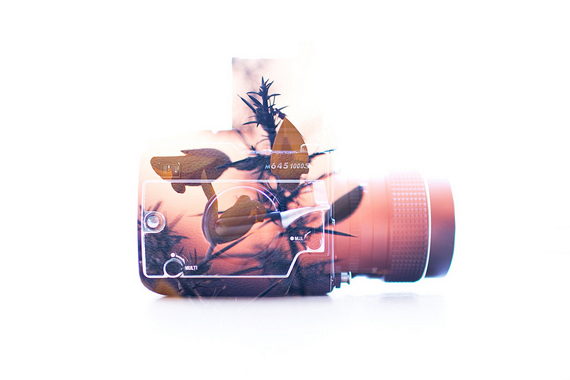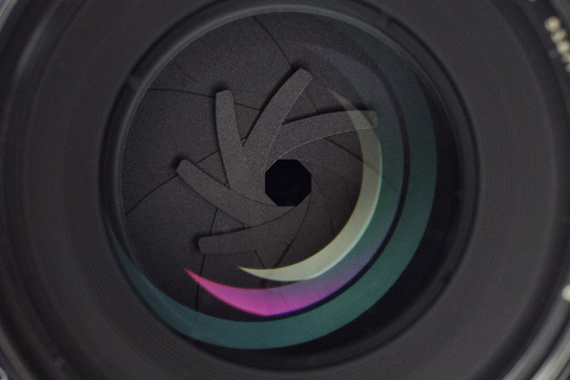In order to understand how EV settings work, you must first be familiar with the concept of f-stop and shutter speed settings.

photo by Ben Harrington
Aperture
Briefly, the smaller the f-stop number, the larger is the aperture size it represents. Each aperture setting is either half or twice the size of its neighbor. So f/8, for example, is half the size of f/5.6, and f/5.6 is twice the size of f/8.

photo by Bryan Jones
Shutter Speed
Similarly, shutter speed steps are also either half or twice as fast as their neighbor. For example, 1/30 is twice as long as 1/60, and 1/60 is half as long as 1/30.
A number of different combinations of aperture size and shutter speed all produce the same degree of exposure. For example, f/5.6 at 1/60 of a second provides the same level of light exposure as f/8 at 1/30 (where the amount of light halves, and the duration of exposure doubles).
Of course, there are even more permutations: f/8 at 1/30 is also the same as f/11 at 1/15 (half the light for twice as long), or f/4 at 1/125 (four times the light for a quarter of the time), and f/2.8 at 1/250 (eight times the light for an eighth of the time), etc.

photo by Elaine with Grey Cats
A one step change to either setting is known as a “one stop” change.
The History of Exposure Value
To simplify the process of setting alternative aperture and shutter speed combinations, a German camera shutter manufacturer called Friedrich Deckel first developed the Exposure Value (EV) concept in the 1950s. The likely impetus for this was the rise in popularity of color film, which required greater exposure accuracy than black and white film photography (modern 35mm color film started to become available in the mid 1930s).
In 1954, numerous camera (and shutter) manufacturers adopted Deckel’s Exposure Value Scale (EVS), including Hasselblad, Kodak, Konica, Olympus, Ricoh, Seikosha, and Voigtländer, to name but a few.
They introduced lenses with coupled shutters and EV scales, such that, after setting the exposure value, adjusting either the shutter speed or aperture made a corresponding adjustment in the other to maintain a constant exposure.
When camera models with built-in light meters started to emerge, some also metered against an EV scale (as opposed to an aperture or shutter speed scale), and correct exposure was accomplished by transferring the meter’s EV reading to the lens, through adjustment of lens apertures and/or shutter speed settings.
What is Exposure Value?
The Exposure Value (EV) is a numerical scale that represents a combination of a camera’s shutter speeds and f-numbers, such that all combinations yield that the same exposure have the same EV value.
Exposure Value scale steps also align with intervals on the photographic exposure scale. In other words, an increment of one step on the EV scale represents a one step (often referred to as a stop) increase in exposure, and conversely a one step decrease corresponds to a one step reduction in exposure. For this reason, some cameras had, and still have, exposure compensation features that are graded as EV steps (e.g. +/- 2 EV).

graphic by Esmer Olvera
For example, if EV 9 corresponds to f/4 and 1/30 of a second, EV 8 is f/4 at 1/15 of a second, and EV 10 is f/4 at 1/60 of a second (plus any other combination of settings that produce the EV scale value).
The EV scale starts at 0, which represents a 1 second exposure at f/1.0. Lenses with an aperture that big are rare, but it’s the same as a 2 second exposure at f/1.4, or a 4 second exposure at f/2, etc.
EV 15 equates to full sunlight with distinct shadows, while EV -4 would be a scene lit by a full moon. An EV is therefore a convenient “system” for describing the quality of light.
The EV scale can thus be used as a rough guide to exposure settings in the absence of a light meter. So EV 14 is hazy sunlight with soft shadows, EV 13 is cloudy bright with no shadows, 12 is overcast, and so on (for a 100 ISO film).
While the EV scale is still in use today (and has some merits in describing lighting conditions), it fell from favor as a means of setting a camera exposure toward the end of the 1960s, when meter coupling became more common, and removed the need to manually transfer a meter reading to lens settings, or even set anything at all (with the camera doing this automatically). In effect, the importance of correct color exposure had been automated, leaving the way clear for casual photographers to concentrate on other aspects of the craft.
While the EV was (and still is) a simple method of expressing two variable settings (aperture and shutter speed) as a single number, the problem with this generalization is that it ignores some fundamental principles of photography: the f-number determines the depth of field and the shutter speed determines the amount of motion blur.
About the Author:
John A Burton has enjoyed photography as a long-time hobby, and also collects old film cameras.
Like This Article?
Don't Miss The Next One!
Join over 100,000 photographers of all experience levels who receive our free photography tips and articles to stay current:






Leave a Reply